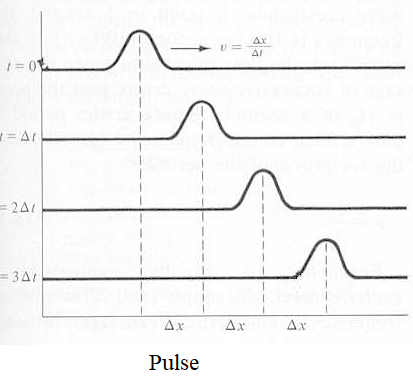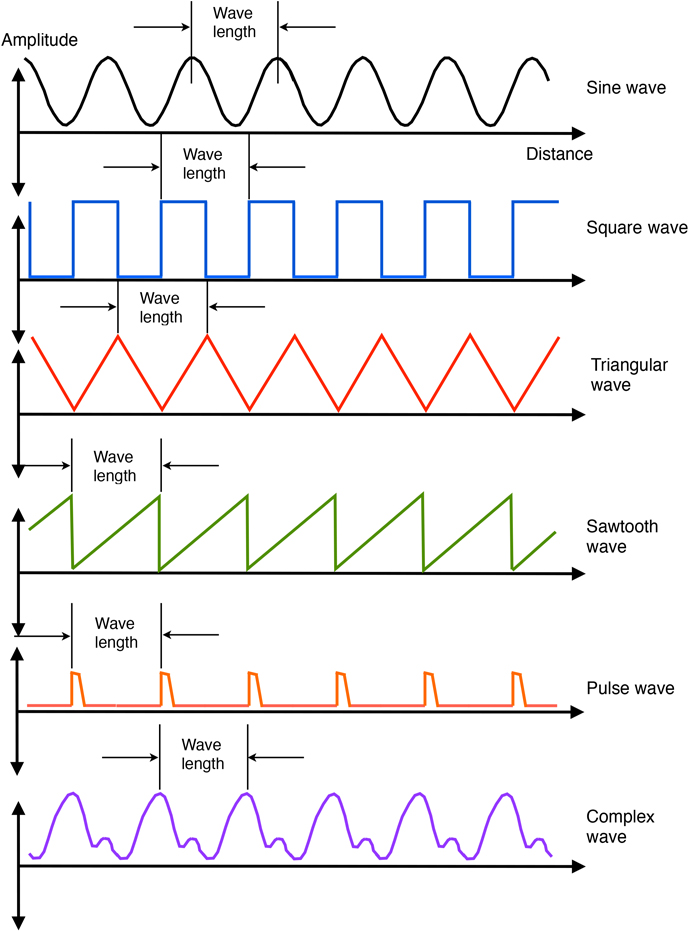Science > Physics > Wave Motion > Wave Motion
The motion that repeats itself after fixed intervals of time is called periodic motion. We know that oscillatory motion is a type of periodic motion. Oscillatory motion is defined as the to and fro motion of an object from its mean position. Examples: oscillation of simple pendulum, vibrating strings of musical instruments, vibration prongs of tuning fork, etc. A simple form of oscillatory motion is Simple Harmonic Motion (SHM). In this motion, the restoring force is directly proportional to its displacement from its equilibrium position. The study of oscillatory motion is basic to physics; its concepts are required for the understanding of many physical phenomena. A wave is an example of oscillatory motion. In this article, we shall study terminology and characteristics of waves.
A wave is a disturbance that propagates, or moves from the place it was created. The simplest waves repeat themselves for several cycles and are associated with simple harmonic motion.
A pulse is one time disturbance lasting for short duration, while a wave usually refers to a continuous disturbance lasting for longer time.



Wave in a medium may be defined as the disturbance moving through the medium without change of form. e.g., ripple in water formed due to dropping a stone in water.
When a stone is dropped in water, it transfers part of its kinetic energy to the particles of water with which it comes into contact. These particles are set into vibration. Now, these vibrating particles give their energy to the neighbouring particles. Thus neighbouring particles are set into vibrations. Thus, each particle receives energy from the previous particle and passes it to the next particle. Thus, wave transfer energy from one point to another.
Wave Motion:
Wave motion is a mode of transfer of energy or a form of disturbance travelling through an elastic medium due to the repeated oscillations of the particles of the medium about their mean positions.
Characteristics of Wave Motion:
- The particles of the medium are not carried along the waves.
- It is the disturbance which moves and forms the wave.
- All the particles of the medium perform S.H.M. about their mean positions, with the same amplitude and period.
- As the disturbance reaches different particles successively, each succeeding particle lags behind the previous particle in a phase.
- Wave motion is both periodic in space and periodic in time. Hence it is a doubly periodic phenomenon.
- The wave velocity is different from particle velocity. The velocity of a wave is constant in a given medium, whereas the velocity of the particle changes, being maximum in the mean position and minimum at the extreme position.
- The wave travels from one medium to another, the wave speed and wavelength change but the frequency remains the same because the frequency is determined by the source.
Wave Motion as Doubly Periodic Phenomenon:

The time taken by a wave to complete its one cycle is called the time period of a wave. Thus, the wave motion repeats after a fixed interval of time. Thus the wave motion is periodic in time.
The distance between two consecutive points which are in the same state of motion i.e. they are in the same phase is always constant and this constant distance is called the wavelength of a wave. Thus, the wave motion repeats after a fixed interval of distance. Hence wave motion is periodic in space.
Thus, wave motion is a doubly periodic phenomenon, periodic in time and periodic in space.
Properties of the Medium Necessary for the Propagation of Mechanical Waves:
- For the propagation of mechanical waves, the medium should possess the following properties.
- The medium must be elastic so that it regains its original condition after the wave passes through it.
- The medium must possess inertia (mass) so that it can store energy and transfer in the form of waves.
- The frictional resistance of the medium should be negligible. so that the medium can travel without loss of energy.
Terminology of Wave Motion:
Phase of a Wave:
Phase specifies the location or timing of a point within a wave cycle of a repetitive waveform. Phase defines the position (in terms of distance from mean position) and velocity of a particle oscillating under the influence of a wave.
Typically, it is the phase difference between the waves that is relevant, rather than the actual absolute phases of the waves. The phase difference is the difference in the phase angle of the two waves.
The particles of the medium which are in same state of motion (at the same displacement from their respective mean position moving in the same direction) are said to be in a phase. In this case, the phase difference is 2nπ where, n = 1, 2, 3, ……
The particles of which state of motion are exactly opposite (displacements from the mean position and velocities are exactly opposite) are said to be out of phase or differing in phase nπ where n = 1, 3, 5, ….

Particles at A and G, B and H are in phase
Particles at A and D, are in exactly opposite phase
Particles at C and E are out of phase
Particles A and B are not in phase
Period of a Wave:
A time taken to complete one cycle or oscillation is called the period of the wave. It is denoted by ‘T’. Its S.I. unit is second.
Frequency of a Wave:
The number of cycles or oscillations performed by a wave in one second is called the frequency of the wave. It is denoted by ‘f’ or ‘ n ‘. Its S.I. unit is hertz (Hz).
When medium changes frequency remains the same.

Amplitude of a Wave:
The maximum displacement of medium particles from their mean positions is called the amplitude of a wave. It is denoted by ‘a ‘. Its S.I. unit is metre.

Speed of a Wave:
The distance travelled by a wave in one second is called the speed of the wave. It is denoted by ‘v ‘. Its S.I. unit is m s-1.
When medium changes velocity of wave changes.
Wave Length of a Wave:
The distance between two successive particles of a wave in the same phase is constant and is called the wavelength of the wave. It is denoted by ‘λ ‘. Its S.I. unit is metre.
When medium changes the wavelength of wave changes.
Wave Number of a Wave:
The number of waves passing through a unit distance is called wave number of the wave. or Reciprocal of a wavelength is called the wave number of the wave. It is denoted by ‘ν’. Its S.I. unit is m-1
Intensity of a wave:
The Intensity of waves is defined as the power delivered per unit area or it is the energy delivered per unit area per unit time. Intensity of wave is proportional to the square of amplitude of the wave. Its S.I. unit is watt per square metre (W m-2)
Intensity = Power/Area
Relation Between Velocity, Frequency, and Wavelength:
Let ‘ λ ‘ be the wavelength, ‘v’ be the velocity, ‘n’ be the frequency and ‘T’ be the time period of the wave. The wave travels a distance equal to its wavelength in one period. Hence the velocity of the wave is given by
Velocity = Distance / time
v = λ /T
But 1/T = n
Hence v = n λ
This is the relation between the wavelength, frequency, and the velocity of a wave.